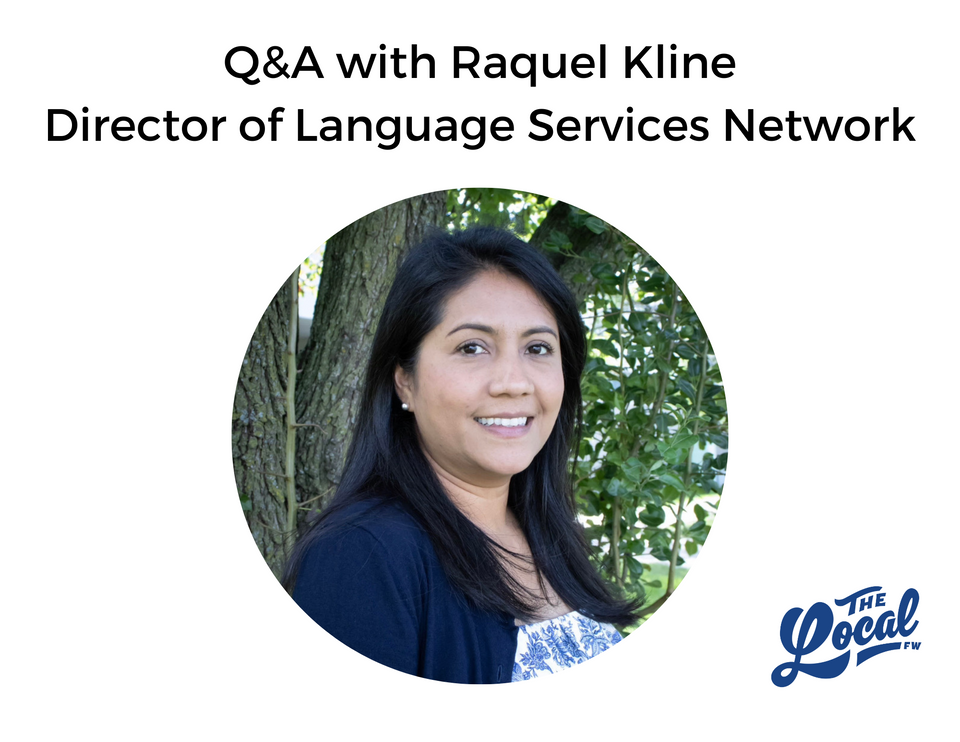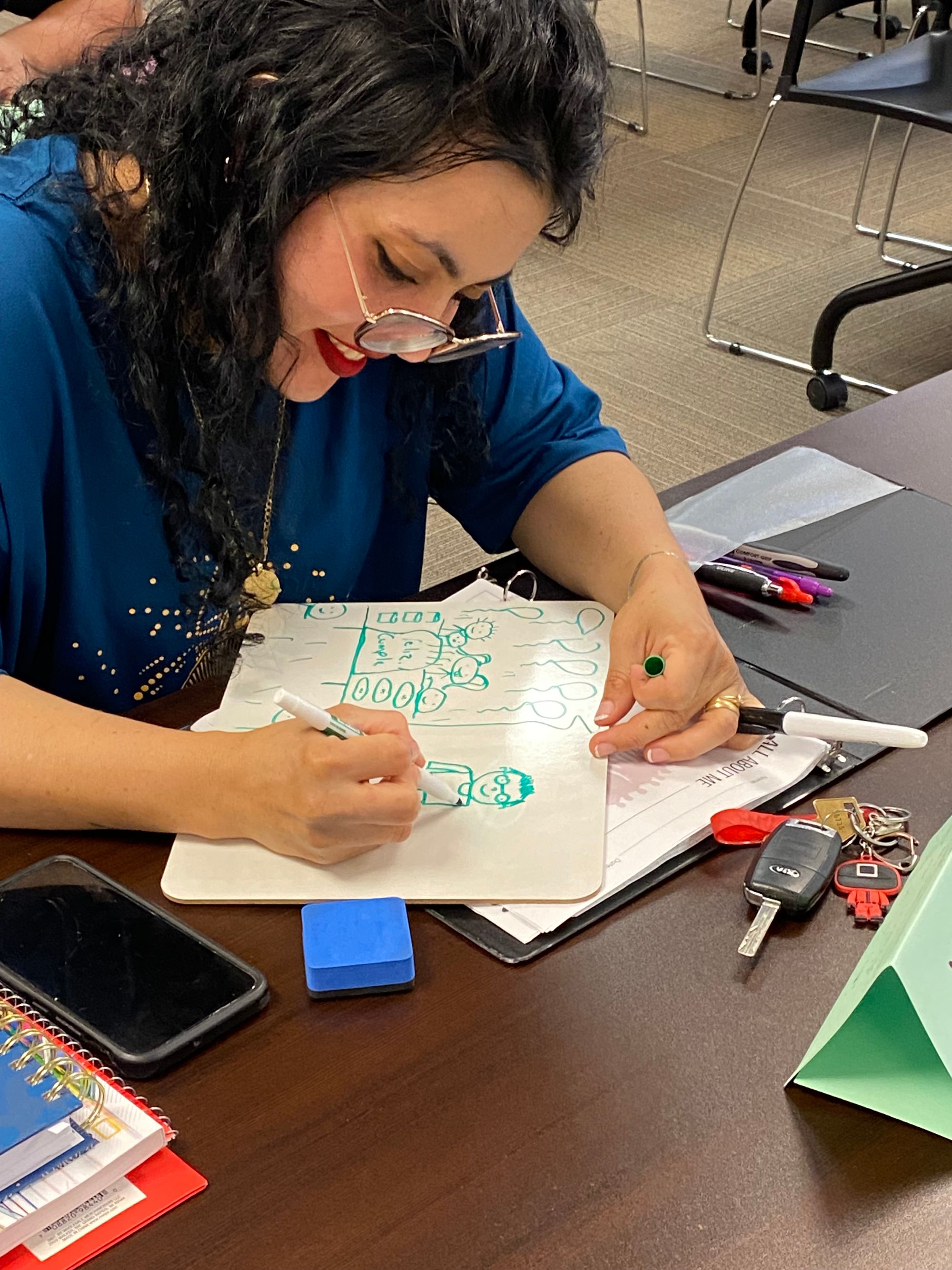Q&A with Raquel Kline of Language Services Network: How welcoming is Fort Wayne?

Each September, Fort Wayne honors Welcoming Week.
It’s an annual series of events, showcasing how the city is striving to be a more welcoming place for all, hosted by Amani Family Services from Sept. 8-15 this year.
As part of the festivities, three Fort Wayne organizations (Amani, Downtown Fort Wayne, and Greater Fort Wayne Inc.) released a new report in partnership with the American Immigration Council called New Americans in Allen County. It shows the critical role immigrants play in the local economy, sustaining the labor force and driving business creation and consumer spending.
“In 2019 alone, immigrants in the county held $496 million in spending power and paid $99.1 million in federal taxes and $61.8 million in state and local taxes,” a press release says. “Despite making up 6.8 percent of the county's total population in 2019, immigrants represented 8.8 percent of its working-age population, 7.8 percent of its employed labor force, and 5.4 percent of its science, technology, engineering, and math (STEM) workers in 2019.”
What’s more, between 2014 and 2019, the total population of Allen County has grown by 3.3 percent, and nearly one-quarter of that growth comes from immigrants alone.
But while the case to welcome immigrants and refugees may be strong, and while the desire may be there, something that often underlies a community's ability to be welcoming is basic access to language and community resources.
As Director of Language Services Network (LSN), a translation and interpretation service funded by Brightpoint, Raquel Kline has witnessed language gaps in Fort Wayne firsthand. And while she believes the community’s intentions may be inclusive, its systems still require some critical adjustments to reduce barriers and enable people of all backgrounds to actively engage in local life.
“Immigrants bring a lot of value to the communities we’re in, but who is supporting these residents, teaching them how to set up a business or lease a home?” Kline asks. “I think we’re missing ways for those who are still learning English to get reliable guidance on how to engage in the community and to accomplish things successfully here.”
The City of Fort Wayne’s Director of Public Information John Perlich says Mayor Tom Henry’s administration is working on two specific ways to enhance engagement and opportunities for people of different languages and backgrounds, complementing its existing Limited English Proficiency (LED) Plan.
“We don’t want language to be a barrier for individuals and families who call Fort Wayne home,” Perlich says.
For starters, the City’s Risk Management Department recently finalized an agreement with the New York-based translation services company, Languagers, Inc., which specializes in phone, mobile and instant video interpretation.
“These services will assist those in need of help (24/7/365), as well as equip city employees and divisions/departments with information that helps address language barriers,” Perlich says.
The city also hopes to contract Kline’s team at LSN for in-person interpretation, as well as the translation of written documents. Kline believes that if all goes as planned, this could be a more all-encompassing way to address language access in Fort Wayne than previous, one-off projects.
Still, there’s room for Fort Wayne to keep learning from cities, like Boston, Minneapolis, Philadelphia and more, which are making strides to engage their international residents and live out what it means to be a welcoming community.
We sat down with Kline to learn more about her experience bridging language barriers in Fort Wayne and how local systems can evolve to be more inclusive.

Tell us more about LSN and how its services fit into the realm of services for international residents in Fort Wayne.
RK: LSN is a program of Brightpoint, which has been funded by various organizations since it started in 2015. It’s housed at The Summit campus, and when we first started, it was just me, working as a consultant to answer community calls and refer international residents to other programs in Fort Wayne. But over the years, LSN has grown to fill some of the gaps we’ve identified ourselves.
We now have two office staff, two ESL instructors and more than 110 linguists. We also work with translators virtually across the U.S. and in Mexico to offer services in about 22 different languages. Our services include face-to-face interpreting, translation, training and language evaluation services for bilingual professionals. We also offer language access consultation, language conversation classes and educational training on best practices for working with interpreters and Limited English Proficient (LEP) clients.
For instance, we might provide interpretation services if you’re an international resident who needs to speak to somebody in the City about zoning, or if you have a tree that falls in your neighborhood, and you need help figuring out who can move it.
Tell us more about your background and how you got into this line of work in Fort Wayne.
RK: I was born and raised in Nicaragua and moved to the United States in 2002. I hold bachelor’s degrees in English as a Second Language Education and translation from Universidad Nacional Autónoma de Nicaragua, and BA with a major in Spanish from Indiana University.
I worked as a medical interpreter and translator for medical groups and other NGO’s doing missionary work in Nicaragua. In 2001, I met my husband in Nicaragua, got married, and moved to the U.S. in 2002. I have lived in Indianapolis, South Bend, and currently call Fort Wayne home.
In the U.S., I have been working as an interpreter and translator for the past 20 years. I have extensive training and experience as a medical, legal and community interpreter and translator. I have a passion and commitment for serving the community and am actively involved with different local not-for-profit organizations as a board member and volunteer.
As an immigrant, I faced challenges, such as going back to school to complete another college degree to be able to get a job, learning the culture and mastering the language. I enjoy giving back to my community if an opportunity arises.
You also helped bring Welcoming Week to Fort Wayne. Tell us about that.
RK: About 10 years ago, I started volunteering with a cool program in Fort Wayne called the Reclamation Project, which has sadly stopped due to a lack of funding and resources. But at the time, it was a citizen-led, grassroots nonprofit working to restore the old Rialto Theatre on Calhoun Street and turn it into a hub where people from different countries and walks of life in Fort Wayne could rent space and create a bodega market/coffee shop experience. They also offered ESL classes, so I started working with them as a translator before I was hired as the main consultant to help launch LSN.
During my time with the Reclamation Project, I was part of the group that helped start Welcoming Fort Wayne and bring the program to our city. When we started the organization, our three big areas of focus were economic growth, access to services and language access. Since then, Welcoming Fort Wayne has evolved and it is now run by Amani, but I’m hopeful that as it continues to grow, language can play an increasingly important role in its work, too.
What are the biggest populations you work with right now at LSN?
RK: Spanish is the biggest, and the second biggest is Burmese. We have also seen an increase in Afghans, Sudanese and people from Haiti. Last June through now, the amount of translation requests we have for French-to-English is off the charts, which is something we haven’t seen before. We used to see about one request for French per month; now, we’re seeing three to five requests per week, and we attribute that to Haitian refugees and immigrants. But overall, our clientele is a mix of populations.
What are some of the top barriers you see international residents facing in Fort Wayne?
RK: The U.S. is not known for being multilingual. Imagine arriving here, unable to speak English, trying to get a job, make friends, or even complete basic tasks, like buying food or filling out forms. To address this, many immigrants and refugees take ESL classes. I believe many people would like to learn English, so they are able to do things on their own here. But finding the time between jobs and caring for kids can be difficult. Fort Wayne needs more ESL classes available, so people can learn to speak English and communicate properly. There’s also a matter of making sure community resources and documents are translated into different languages to help residents who are new and still making the transition.
Accessing services is another barrier. Undocumented immigrants have an especially difficult time accessing services, largely because they are afraid of being deported. Those who are legal do not necessarily know how to navigate the systems and have difficulty speaking English and limited transportation. Transportation, like language, is a challenge and affects nearly every aspect of life for refugees and immigrants. Obtaining a driver’s license is extremely difficult for a variety of reasons.
Housing can also be a challenge. For instance, if an international resident wants to buy or lease a house in Fort Wayne, how do they learn the process? It’s complicated enough in English, so if you’re still learning the language, I cannot imagine how complicated it would be.
How can Fort Wayne address some of these challenges?
RK: Fort Wayne could do more to make sure people are guided through processes, like homeownership or entrepreneurship, and ensure that international residents are not being taken advantage of. Unfortunately, that’s something we see a lot at LSN, even in our own community. There are people who prey on those who don’t know how to navigate the system. Immigrants and refugees are easy victims for discrimination and exploitation at the workplace, too. Some employers recognize the sense of urgency among these groups to keep their jobs and offer them less desirable and more dangerous roles.
That said, I don’t think most people in Fort Wayne are necessarily trying to be unwelcoming to international residents. I think there’s a general feeling of “welcomeness” here, but there’s also a lack of practical programs and services for non-English speakers to engage with the community and to assume more leadership roles in civic life.
Another thing I see consistently in Fort Wayne is a lot of our current immigrant and refugee services are associated with churches, and sometimes people of different faiths steer away from those programs because they’re afraid churches are trying to convert them. So international people need and want help, but if it’s tied to something that might change who they are or affect their religion, they will probably avoid that.
Overall, there’s a general lack of funding for language services and for all services that work with international populations. So increased funding could help fill some of these gaps.
Despite all these challenges, the people I have worked with are incredibly strong and grateful for the opportunity to be in the U.S. Most of them have such basic desires: To get a job, to have their children succeed in school and to be able to put a roof over their heads.
Tell us more about LSN’s ESL classes specifically.
RK: Our ESL classes are designed for adults and are basic English. We chose to focus on the basics, so we don’t duplicate efforts. A lot of other organizations in Fort Wayne that offer ESL courses can’t support the very early-stage speakers, so we pick up those students. And since we work with mostly adults, we equip them with several phrases to communicate well in the workplace.
We really focus on learning to speak the language first, and then learning proper grammar later, once speakers feel empowered and feel like they’re making progress because English is a very difficult language to learn. Once clients pass the basic levels of ESL with us, we refer them to other organizations, like the Literacy Alliance or Anthis Career Center at Fort Wayne Community Schools for further language education.
What are some of the biggest misconceptions you see about immigrant and refugee populations?
RK: Immigrants and refugees who are educated and who formerly had strong jobs back home find it frustrating that they can’t obtain the same jobs here. I think a common misconception is that immigrants are “needy,” when there are actually a lot of people here who have really good degrees back in their home countries, but oftentimes, they’re not able to practice their professions here due to language barriers or a lack of certifications or exams.
A lot of our clients at LSN work in the service industry, cooking or washing dishes; many also work in construction and manufacturing. But Fort Wayne could be more welcoming by helping residents who do have higher degrees to achieve the same professions that they had back home.
Not that it’s going to happen right away, but it would be helpful to have some infrastructure in place, where if you have a degree in law, for instance, you could go and talk with specific people in law offices in Fort Wayne who guide you through the process to transfer your knowledge here and eventually hire you.
What other cities or models have you seen for programs you admire?
RK: There is a program called Upwardly Global that works with recently arrived immigrants and puts them through training to help them get into specific organizations in their field of study or get recertified so they can re-enter the same professional fields they worked in back home. They have offices in Chicago, New York, San Francisco and Washington, D.C. Of course, these are bigger cities, so we might have to scale a program like this for Fort Wayne. But I think we need to look outside of Allen County for inspiration more often and remember that: We don’t have to reinvent the wheel.
Fort Wayne could also really use a Language Access Plan. I used Philadelphia, PA; New York, NY; and Minneapolis, MN, as models when I drafted the first Language Access Plan for Fort Wayne in 2015 when LSN began. Since then, I’ve been advocating for this to become a citywide initiative. Without this infrastructure in place at the city level, we will run into the same issues repeatedly with our international citizens because not speaking English is a barrier to accessing any services.
Other cities, like Boston, MA, also have great immigrant advancement programs. Nashville, TN, has a program called Conexión Américas, which creates opportunities for Latino families to belong, contribute and succeed. And San Francisco, CA, has a program called La Cocina, which works to solve problems of equity in business ownership for women, immigrants and People of Color.
Places, like Mohawk Valley, NY, are doing great work, too.
Looking to the future, what are a few specific changes you would like to see in Fort Wayne?
RK: I would love to see more civic participation from our international community in city meetings and boards, particularly when the city is discussing funding that will affect a specific population that lives in a certain area, like the recent Six-Mile Creek Trail, for instance.
We got a call to provide interpretation services for a meeting about the trail, but the call came in last minute, the day before the meeting was scheduled, so if we had more notice for meetings like that, we could work harder to engage the community and to make sure they were heard.
I would also love to see more representation of our international residents working at the city or being appointed to high-level city and county boards. The way Fort Wayne’s community looks demographically is much more diverse than our most powerful leadership roles represent, and sometimes, people are making decisions on behalf of international residents without talking to those communities first.
Many years ago, United Way had a program called Blueprint, which trained average citizens on how to become more active community members and join nonprofit boards. The training provided an opportunity to shadow leaders at various meetings. I think a program like this could be very beneficial — especially if it was available in multiple languages.
